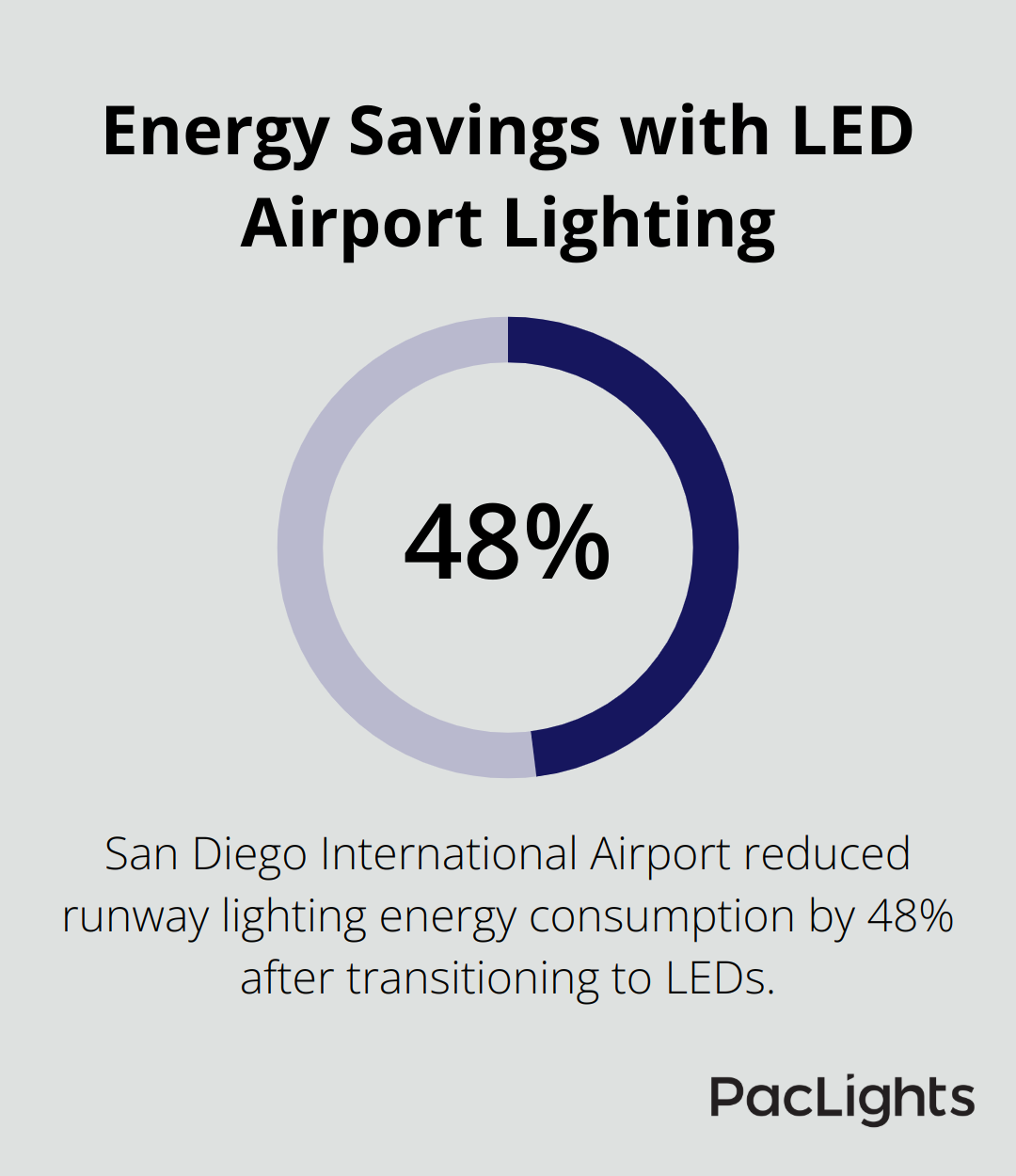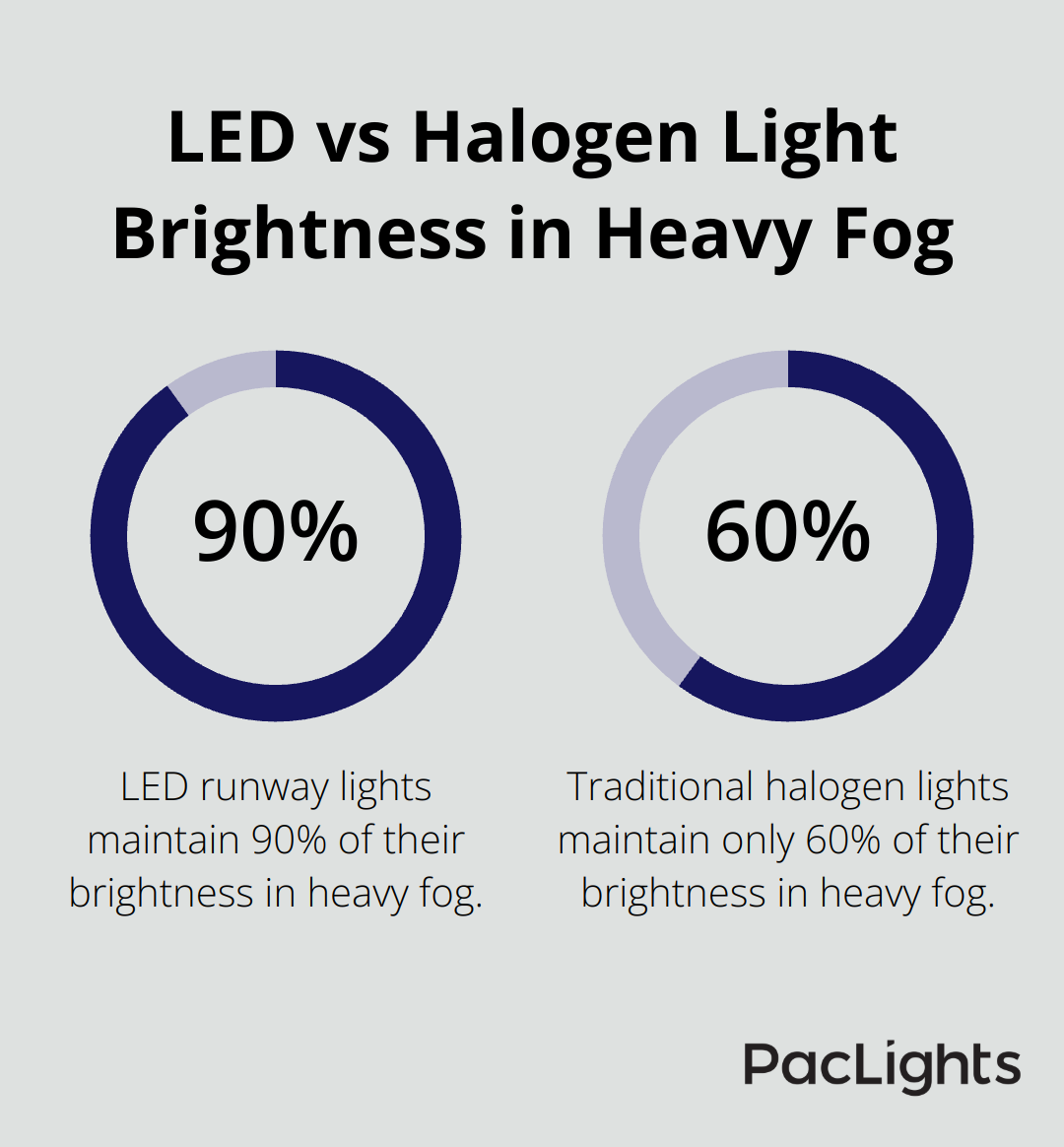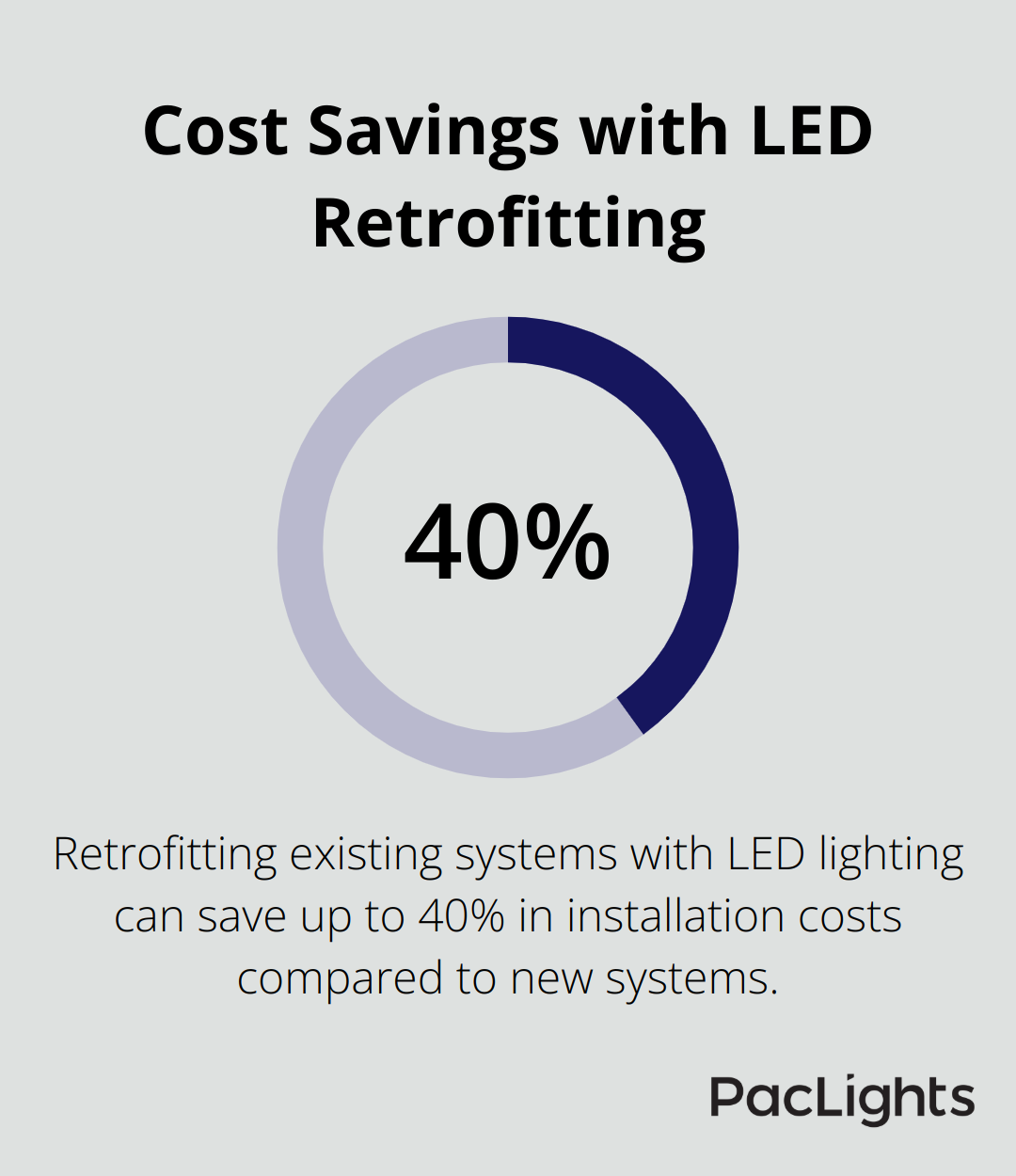LED airport lighting has revolutionized aviation safety and efficiency. At PacLights, we’ve witnessed firsthand the transformative impact of this technology on runways, taxiways, and approach systems worldwide.
This comprehensive guide explores the key components, benefits, and considerations of LED lighting in airport environments. We’ll shed light on how these advanced systems enhance visibility, reduce costs, and improve overall airport operations.
What Makes LED Airport Lighting Essential?
Illuminating Runways and Taxiways
LED airport lighting transforms aviation safety and efficiency. Key components work in unison to create a safer, more cost-effective lighting system for airports of all sizes.
Runway edge and centerline lights play a vital role in guiding aircraft during takeoff and landing. LED fixtures for these applications provide superior visibility, even in challenging conditions. A Federal Aviation Administration (FAA) study revealed that LED runway edge lights are visible from up to 3.5 miles away, compared to 2.9 miles for traditional incandescent lights.
Taxiway lights and guidance signs also reap significant benefits from LED technology. The crisp, clear light emitted by LEDs helps pilots navigate complex taxiway systems with greater ease. This proves particularly important at large airports where taxiway layouts can be intricate and potentially confusing.
Enhancing Approach Lighting Systems
Approach lighting systems (ALS) provide critical visual guidance to pilots during the final stages of landing. LED-based ALS offer several advantages over traditional systems:
- Improved visibility in fog and other adverse weather conditions
- Reduced glare (which can disorient pilots)
- Adjustable brightness levels based on ambient light conditions
These improvements contribute to safer landings and reduce the risk of runway overruns or other incidents.
Driving Energy Efficiency and Cost Savings
The most compelling argument for LED airport lighting lies in its energy efficiency and cost-saving potential. Airports that switch to LED lighting report significant reductions in energy consumption and maintenance costs.
San Diego International Airport serves as a prime example. After transitioning to LEDs, the airport reduced its runway lighting energy consumption by 48%. This translates to substantial cost savings over time, especially considering that airport lighting systems often operate 24/7.

Maintenance costs also decrease dramatically with LED lighting. Traditional incandescent bulbs typically last around 1,000 hours, while LED fixtures can last up to 50,000 hours or more. This results in fewer replacements, less downtime, and lower labor costs associated with maintaining the lighting system.
Weather Resistance and Durability
LED airport lighting fixtures demonstrate exceptional durability in harsh weather conditions. These robust lights withstand extreme temperatures, heavy precipitation, and even salt spray in coastal areas. Their resilience ensures consistent performance and reduces the need for frequent replacements due to environmental damage.
Smart Control Systems Integration
Modern LED airport lighting systems integrate seamlessly with smart control systems. This integration allows for real-time monitoring, remote management, and adaptive lighting schemes. Airport operators can adjust light intensity based on traffic patterns, weather conditions, or time of day, further optimizing energy usage and enhancing safety.
As we move forward, the next chapter will explore how LED airport lighting improves safety and performance across various airport operations.
How LED Airport Lighting Enhances Safety and Performance
LED airport lighting transforms safety and performance in aviation operations. This advanced technology revolutionizes visibility and reliability across airport environments.
Unmatched Visibility in Challenging Conditions
LED lights provide clear, crisp illumination even in adverse weather. An International Civil Aviation Organization (ICAO) study found that LED runway lights maintain 90% of their brightness in heavy fog, compared to only 60% for traditional halogen lights. This improved visibility contributes to safer takeoffs and landings, especially during low-visibility operations.

Rapid Response for Dynamic Lighting Needs
The instant on/off capability of LED lights revolutionizes airport operations. Traditional lighting systems can take up to 10 minutes to reach full brightness after activation. LED lights, however, reach full intensity within milliseconds. This rapid response allows airports to adjust lighting levels quickly based on sudden weather changes or emergency situations (enhancing overall safety).
Superior Color Rendering for Accurate Visual Cues
LED lights offer superior color rendering compared to traditional lighting sources. The Color Rendering Index (CRI) for high-quality LED airport lights typically ranges from 70 to 90, while traditional halogen lights score around 60. This improved color accuracy helps pilots distinguish between different types of runway and taxiway markings more easily (reducing the risk of navigation errors).
Minimized Maintenance Downtime
The long lifespan of LED fixtures significantly reduces maintenance-related disruptions. A report by the Airports Council International (ACI) indicates that airports using LED lighting experience 75% fewer light outages compared to those using traditional systems. This increased reliability ensures that critical lighting systems operate when needed most.
Energy Efficiency Boosts Operational Reliability
The energy efficiency of LED lighting indirectly contributes to safety by improving operational reliability. Airports using LED systems report up to 70% reduction in energy consumption for lighting. This decreased load on power systems reduces the likelihood of electrical failures or brownouts that could compromise safety-critical systems.
As we explore the installation and maintenance considerations for LED airport lighting in the next chapter, it becomes clear that these systems offer a comprehensive solution for modern aviation infrastructure.
How to Successfully Implement LED Airport Lighting
Retrofitting vs. New Installations
Airports face a choice between retrofitting existing systems and installing new LED lighting. Retrofitting often costs less upfront. The Airport Cooperative Research Program found that it can save up to 40% in installation costs compared to new systems. However, retrofitting may limit the full potential of LED technology due to compatibility issues with older infrastructure.

New installations allow for optimal design and performance. They enable airports to take full advantage of LED capabilities, including advanced control systems and future-proofing for upcoming technologies. The FAA reports that new LED installations can reduce energy consumption by up to 75% compared to traditional lighting systems.
Maintenance Staff Training
Proper training for maintenance staff improves the longevity and performance of LED airport lighting systems. The Airports Council International recommends a minimum of 40 hours of specialized training for technicians working with LED systems. This training should cover topics such as troubleshooting, repair techniques, and safety protocols specific to LED technology.
Airports that invest in comprehensive training programs report a 60% reduction in maintenance-related downtime. This improvement stems from faster problem identification and more efficient repair processes. Regular refresher courses keep staff up-to-date with the latest advancements in LED lighting technology.
Ensuring Compatibility and Integration
Compatibility with existing control systems challenges many airports when implementing LED lighting. A survey by the International Airport Review found that 35% of airports experienced integration issues during LED upgrades. To mitigate these challenges, thorough system audits and compatibility assessments must precede installation.
Many airports implement phased replacements, gradually upgrading sections of their lighting system to ensure smooth integration. This approach allows for real-time problem-solving and minimizes disruptions to airport operations. When selecting LED lighting solutions, airports should prioritize products with proven compatibility records and robust integration support.
Weatherproofing for Harsh Environments
Airport lighting must withstand extreme weather conditions (from scorching heat to freezing temperatures and corrosive environments). LED fixtures designed for airport use undergo rigorous testing to ensure durability. The International Electrotechnical Commission (IEC) sets stringent standards for outdoor lighting, including IP66 and IP67 ratings for dust and water resistance.
Airports in coastal areas face additional challenges due to salt spray corrosion. In these environments, LED fixtures with marine-grade aluminum housings and specialized coatings show 30% longer lifespans compared to standard fixtures. Regular inspections and preventive maintenance can extend the life of LED airport lighting systems by up to 25%.
Final Thoughts
LED airport lighting has revolutionized aviation safety and efficiency. These advanced systems offer unparalleled visibility, energy savings, and operational reliability for airports worldwide. Airports benefit from reduced maintenance costs, improved pilot guidance, and enhanced safety in all weather conditions.
We anticipate exciting developments in LED airport lighting as technology advances. Smart, interconnected systems will optimize energy use and adapt to real-time conditions. Emerging technologies like solar-powered LEDs and advanced sensors will further enhance efficiency and safety.
At PacLights, we offer tailored LED airport lighting solutions designed to meet the stringent requirements of aviation environments. Our expertise in energy-efficient lighting extends to runway edge lights, taxiway guidance signs, and other critical airport fixtures. We strive to provide the reliability and performance needed for safe and efficient airport operations.


Disclaimer: PacLights is not responsible for any actions taken based on the suggestions and information provided in this article, and readers should consult local building and electrical codes for proper guidance.